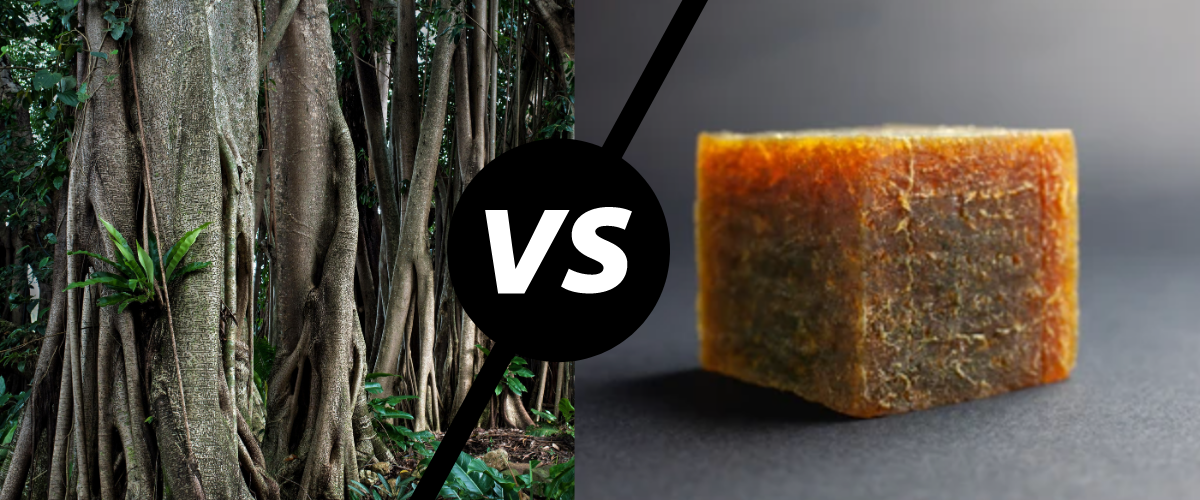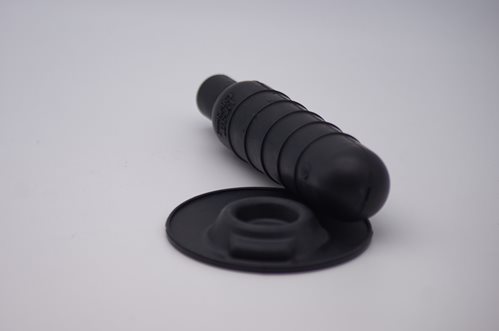Natural and synthetic rubbers are essentially two halves of the same whole. But each half brings properties, advantages and uses unique to that type of rubber. Natural rubber conveys imagery of rubber trees tapped in the depths of the rainforest while synthetic rubbers call to mind traditional manufacturing and oil processing.
Is one type of rubber better than another? Are you better off going au natural or keeping things a bit more artificial? Let’s start with an in-depth look at both options.

What is natural rubber?
Natural rubber is a rubber material found in nature. It is produced by tapping trees, similar to maple syrup, not by processing oil. Over 2,500 different kinds of trees produce latex, but the most common is the aptly named rubber tree. Latex emerges from the tree in a thick, milky sap which is then processed. Processing typically involves removing excess water and leaving the natural rubber in smokehouses or outdoors to air dry. It is then placed into bales and shipped to manufacturers.
Natural rubber dates back thousands of years to civilizations like the Inca, who would use rubber to make balls for ancient sports. Back then, the biggest downside to natural rubber is that it would start to melt or get sticky when the temperature got too warm. It wasn’t until 1839 that Charles Goodyear accidentally dropped rubber on a hot stove, then went on to patent the process of vulcanization to better stabilize natural rubber and keep it intact.
Today’s natural rubber usually comes from rubber tree plantations. Rubber trees six years or older
can be tapped annually for around 24-30 years. Some farmers prefer to tap more intensely early on while others tap latex as long as possible. There has also been a movement in the past decade for rubber tree plantations to move toward more sustainable practices, a movement which is still developing worldwide.
Uses for natural rubber
Natural rubber is used as a raw material in a wide variety of over 10,000 consumer products. Applications include:
- Tires for cars and aircraft
- Surgical gloves
- Rubber bands
- Medical devices
- Clothes
- Motor mounts
- Pacifiers and children’s toys
- Balloons

What is synthetic rubber?
Synthetic rubber, simply put, is any type of rubber that cannot be classified as natural rubbers. Synthetic rubbers are produced artificially by creating polymers via solution polymerisation or emulsion polymerisation.
With so many different types of synthetic rubbers available on the market, it’s difficult to generalize them all as one category of rubber with similar properties. The common denominator is that they are all byproducts of oil. But the diversity in synthetic rubbers means many different types are produced using different formulas, and each type has different properties designed to suit different applications.
 Fun Fact:
Fun Fact: Chewing gum was made with natural rubber until after World War 2, when synthetic rubbers like polyethylene and polyvinyl acetate were developed as an alternative. Natural rubber gum is making a comeback, but today’s mainstream gum brands usually include some sort of synthetic rubber ingredient.
What are the Different Types of Synthetic Rubber?
Uses for synthetic rubber
Synthetic rubbers have a wide variety of uses, and can be found in almost every conceivable rubber application, especially considering some people are allergic to latex and require synthetic alternatives to natural rubber products. Applications include:
.png)
Is natural rubber more expensive than synthetic?
Natural rubber is sometimes more expensive than synthetic, but not all the time. Cost is extremely variable, based on several different factors.
Natural rubber comes from trees. If one plantation plants more trees one year, then eight years later they may produce a surplus of natural rubber. Another plantation may have a bad year for crops, leading to a future shortage of natural rubber the market won’t feel for years. Because natural rubber is considered a commodity where many different sources are creating the same or equivalent products, natural rubber is the only raw material in the industry that can be traded on a futures market.
Both types of rubber, natural and synthetic, are also vulnerable to demand-side factors, including how many manufacturers and distributors are interested in purchasing rubber products in a given year. This is illustrated especially in the automotive market. If more cars are produced, more rubber will be needed to create tires, for example.
Numerous factors, especially the volatility of natural rubber, mean the price is sometimes unstable and always difficult to predict. Some sources will say synthetic rubber is more reliably inexpensive, but in our experience, prices are not stable enough to declare one type cheaper than another overall. In fact, in many products or applications, natural rubber and synthetic rubber are combined in a formula, and the mix ratio can be changed relatively easily. This helps keep some synthetic prices in line with natural rubber.
Should you use natural rubber or synthetic rubber?
Like many things in the rubber industry, it depends. Though they may seem like the only two options in the umbrella of rubber types, one look at the different properties of each type of rubber shows that comparing natural and synthetic rubber is not always simple.
Both natural and synthetic rubbers can be great insulators, non-reactive and work well as adhesives or coatings. However, which one to use depends entirely on your application and the type of natural or synthetic rubber that will work best.
One of our favorite metaphors is comparing natural and synthetic rubber to sports shoes. There’s no one sneaker perfect for every sport. Track shoes are best for gripping the track, basketball shoes are good for running the court and soccer cleats are great for getting a grip in unstable turf. In the same way, there’s no one best type of rubber for every application. Each type has its own advantages and drawbacks.
That being said, it is possible, and not at all uncommon, to combine natural rubber with some synthetic rubbers in formulas that can take advantage of multiple characteristics.
Talk with us to determine which formula is best for your application.
Advantages of synthetic rubber
Broadly speaking, synthetic rubbers generally have several advantages in comparison to natural rubber, including:
- Temperature resistance
- Chemical resistance
- Weather, ozone and sunlight resistance
- Better flexibility at lower temperatures
- Better electrical insulator
- Price and supply not affected by on weather, crop health or rubber plantation stability
Advantages of natural rubber
It’s difficult to compare natural rubber to the vast expanse of synthetic rubber options, but it does have a few general advantages, including:
- Excellent tear and abrasion resistance
- Very low compression set values
- Good vibration dampening characteristics
- High tensile strength
- Good adhesion to itself and other materials
The following table shows some of the properties of natural rubber in comparison to several synthetics:
| MATERIAL |
ABBREVIATION |
VIBRATION
ISOLATION |
RELATIVE PRICE |
TEMPERATURE RANGE |
OZONE, UV RESISTANCE |
OIL RESISTANCE |
| Natural |
NR |
Excellent |
Good |
-60F to 220F |
Poor |
Poor |
| Butyl |
IIR |
Excellent |
Fair |
-75F to 250F |
Good |
Poor |
| Ethylene-Propylene |
EPDM |
Good |
Excellent |
-70F to 250F |
Excellent |
Poor |
| Nitrile |
NBR |
Good |
Good |
-30F to 250F |
Poor |
Excellent |
| Neoprene / Chloroprene |
CR |
Excellent |
Excellent |
-60F to 220F |
Good |
Fair |
| Silicone |
VMQ |
Good |
Fair |
-175F to 450F |
Excellent |
Fair
|
When selecting any type of rubber material, the key thing is to understand the final product’s application and desired characteristics as well as the environment it will be in. From there, you can pick the most cost effective polymer that meets your requirements.
Not sure what type of rubber is best for your application? Custom Rubber Corp. has decades of experience in helping customers select the best, most cost-effective option for their business needs. Get your rubber materials questions answered by a team of experts today.